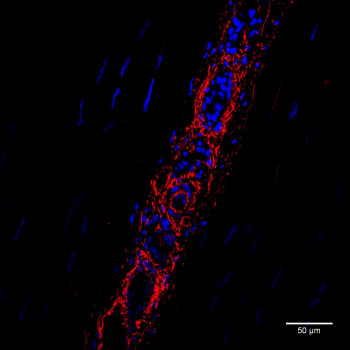Project
Establishing the Role of Elastin in Tendon Function
| Primary Investigator: | Marta Godinho |
| Co-investigators: | Hazel Screen |
| Steve Greenwald | |
| Chavaunne Thorpe | |
| Funder: | Bonfield Scholarship - Institute of Bioengineering Queen Mary University of London |
This project aims to characterise energy storing tendon function, establishing how these specialised tendons stretch and recover so effectively and why this ability deteriorates with ageing or disease. This knowledge will help develop evidence based therapies for common tendon pathologies which are currently difficult to treat.
Tendons connect muscle to bone and facilitate joint motion. Whilst all tendons are passive structures, some additionally act to increase the efficiency of locomotion, by stretching and storing energy during landing which they can release later during the locomotion cycle.
This function is critical for managing energy expenditure in humans and animals, and tendons performing this function are known as energy storing tendons. The high strain energy storing tendons must withstand make them prone to highly debilitating and painful injuries, known as tendinopathies. Tendinopathies are increasing prevalent, but extremely difficult to treat, mainly as we have very limited understanding of the aetiology and pathophysiology of these conditions.
Our recent research has focused around understanding how energy storing tendons can behave more elastically and stretch further than positional tendons. We have recently discovered two key energy storing tendon specialisations; individual fascicles are helically wound like spring for elasticity and the matrix between fascicles if load bearing and elastic in nature, allowing the fascicles to slide when loaded and slide back following unloading? (Thorpe et al. 2012) Our group has additionally demonstrated that a loss of these specialisations with ageing leads to reduced tendon resistance to fatigue damage.
Unraveling these mechanism has exciting implications for treating tendon injuries, not only providing new avenues for developing treatments, but also for targeting prevention approaches to stop age related loss of tendon elasticity. Our recent data suggests that changes to the interfascicular matrix (IFM) with age are primary cause of tendon overload damage. However, very little is known about the IFM. Our still unpublished recent data demonstrates the presence of high levels of proteoglycans in the IFM, and also elastin bridging across the IFM, linking fascicles.
Elastin is an important load-bearing tissue in the bodies of vertebrates, used specifically in tissues requiring high fatigue resistance or energy storage, as a result of its highly elastic mechanical behaviour and resilience. Studies of elastin have generally focused on the cardiovascular system, where elastin turnover or repair rate has been shown to be very slow, resulting in a gradual decline in its efficacy in these tissues with age. Studies of elastin in tendon are limited in number, and draw no firm conclusions. There remains debate concerning its abundance, or even presence, and no role for elastin in tendon has been identified.
We have some preliminary data indicating that elastin is localised to the IFM of tendons and ligaments, where it may act to facilitate the sliding and recoil of fascicles. This project builds on these data, hypothesising that: The IFM in energy storing tendons is specialised, with elastin links between fascicles. These links are critical in facilitating the high strain and rapid recoil behaviour essential for function in these tendons.


